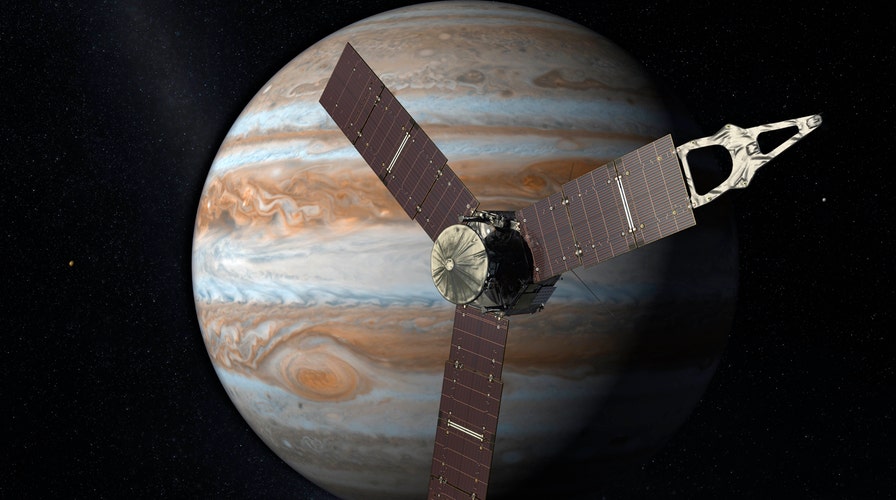NASA's Juno spacecraft set for close encounter with Jupiter
NASA scientists hope for historic Fourth of July, as spacecraft arrives at its destination after a five year, 1.8 billion mile journey
While Americans are anticipating a national holiday on Monday, July 4— and a day off from work— NASA is holding a countdown of its own, marking the days, hours, minutes and seconds until its Juno spacecraft arrives at Jupiter on the same day.
Juno blasted off nearly five years ago, in August 2011. And when it arrives at Jupiter on July 4th, it will be traveling insanely fast— about 165,000 mph at first, and later even 168,000 mph, measured relative to Earth. And that, NASA says, makes it the fastest human-made object ever, if measured relative to Earth.
But the patriotic arrival date is a happy coincidence, according to the project’s principal investigator, Scott Bolton, who directs the space sciences department at the Southwest Research Institute in San Antonio, Texas.
“We did not actually select July 4,” Bolton told FoxNews.com during a June interview. “Celestial mechanics selected it.”
Related:
A variety of factors led to the spacecraft arriving on that date, he said. And an earlier plan had called for a different launch date that would have caused Juno to get to Jupiter at a different time. Once July 4 became the arrival date, he said there would have been a cost in terms of fuel, and less time to do science, if they moved it off Independence Day.
“It came by accident, and it wasn’t worth paying to move it away,” he said.
But even if it was a coincidence, Bolton said that he’s happy with the craft’s arrival date.
“The fact that it came about in a natural way, doesn’t mean that it doesn’t have symbolism and some importance to us all. And I think it’s a nice coincidence, that we happen to arrive on our national holiday, where we’re celebrating our independence. And we celebrate with fireworks. And of course, Juno is going to provide its own fireworks.”
That’s because it will fire its motor on the evening of July 4th, Pacific time, and will burn for an expected 35 minutes to slow the craft to get into orbit. NASA says the burn will begin at 8:18 p.m., PDT.
Everything about the Juno mission is big. With three big solar panels, each about 33 feet long, the craft itself looks like a giant spinning fan. Its size is frequently compared to a basketball court. It will be exposed to high levels of radiation as it investigates Jupiter— the biggest planet in the solar system— and electronics are in a titanium vault for protection.
The buildup surrounding Juno’s arrival has been big too, with science lessons from Bill Nye, a dramatic cinema-style trailer from NASA previewing the mission, and even a collaboration with Apple on a Juno film, nearly nine minutes long, about the connections between science, art, and music.
Juno’s mission includes studying the composition of the planet, whether or not it has a solid core, and its magnetosphere and polar aurora. The craft has already entered Jupiter’s magnetic field, NASA says, and is in autopilot mode.
But Bolton said that a main goal of the mission is also a broad one— because of Jupiter’s early formation in the history of our solar system, and the elements it has, it holds clues that can help scientists better understand planets and even life.
“One of our most important goals is to just improve the fundamental understanding of how our solar system formed,” he said. “In other words, we really want to learn the recipe for solar systems. How do you make planets?”
Follow Rob Verger on Twitter: @robverger

